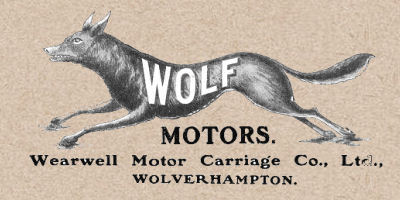


1903 Late in the year the company began to use the Wolf name on the Wearwell Motette forecar, when it was revised to use an 3½ hp water-cooled Stevens engine with chain drive to a Bowden rear-hub with clutch.
From this modest start came a good range of singles and V-twins, using Stevens engines ranging from 2½ hp to 5hp. These were fitted to solos, forecars and even a three-wheeled car, which they built for a couple of years.
At the bottom end was the Wolf Featherweight, with its 1½ hp Stevens engine mounted inclined high up in the frame with belt drive over a jockey pulley. All models had many options and improved through the Edwardian era, in line with most other makes.
1911 During the year, the Wulfruna name began to be used by the firm, with the range down to three singles all with Stevens engines.
1910 Stanley Show Report
Wulfruna Engineering Co.
Wolverhampton. Stand No. 265X.
Two models of the Wulfruna motor-cycles will be staged, one being the Wulfruna feather-weight Royal model B, the specification of which contains 1 1/2 H.P. engine, magneto ignition, 26 by 2in. tyres, weighing about 851bs., and retailing at £29. The Wulfruna 2 H.P. Grand Model B has a single-cylinder engine, magneto ignition, Hutchinson's 2in. motor tyres, and complete with Druid fork and all the latest improvements, retails at £35.
1912 There was a V-twin fitted with a Moto-Reve engine. That year they were also advertised as using Arno engines and Thornton two-speed gears.
1913 Late in the year the tanks again carried the Wolf name and the machines were using JAP as well as Arno engines, an Illston for the 2½ hp model, and a variety of transmissions, many with chain drive.
1914 See Wolf 1914-1915
1916 The range continued until that year, using Villiers, TDC, JAP and Abingdon engines. War-time restrictions brought production to a halt.
Post-War. The range continued in reduced form, with just a 269cc Villiers two-stroke model. This was soon joined by a 292cc sv JAP model, plus two machines with 348cc and 545cc sv Blackburne engines.
In time the range increased with changes every season until the mid-1920s, mostly with chain-cum-belt transmission.
1924 By now, all-chain drive and three speeds had been introduced on some models. There were also ohv sports models with Blackburne engines.
1925 A 172cc Villiers sports model arrived and stayed in the range for a few years.
1927 The sports model was accompanied by two variants with 147cc Villiers engines. All the four-strokes had gone.
1928 Production fluctuated on and off and then ceased as the world recession deepened into depression.
1931 They returned to the fray with two models, again using Villiers engines - of 147cc and 196cc. As the 1930s progressed they expanded their range to add 98cc, 122cc, 148cc and 249cc engines at various times, and built lightweight models throughout the decade.
1940 Production ceased.
Sources: Graces Guide, The Motor Cycle
If you have further information or a query related to this page, please contact us